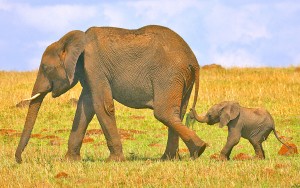
The use of herbs is an effective way to nurture our body’s self-regulatory system and maintain a balance of energy. As mentioned in the previous blog post, Yin and Yang, every herb has a “taste” that has a certain affinity for a particular meridian, so herbs are selected based on which meridian an ailment is located in. The taste and nature of an herb determines how effective it is for treating a specific ailment. There are five tastes and four natures that we use to classify herbs. The five tastes are acrid, sweet, bitter, sour, and salty. Each taste implies certain properties and therapeutic actions of the herb. For example, sweet herbs function to tone, improve, moisten, and harmonize many important systems of the body. They act to relieve urgency and inhibit pain caused by muscle constriction. Sweet herbs are commonly used to treat conditions like dry cough and gastrointestinal dysfunction.
The four natures are hot, warm, cool, and cold. The natures refer to the intensity of yin (cold) and yang (hot) where hot/cold represents the extremes and warm/cool represents the intermediates. The natures were named based on their ability to alleviate acute heat and cold syndromes. For example, an herb that is designated as hot in nature will cause a burning sensation in the mouth and stomach when ingested. Hot herbs act to expel cold, stimulate metabolism, restore yang, and are mainly used for cold-syndrome. Conversely, cold herbs have the ability to alleviate heat-syndrome. They act to reduce a fever by clearing heat, purging fire, and eliminating toxic materials. The nature of an herb is not fixed. Traditional processing is seen as a transformative function, so when an herb is processed there is a change in its nature. Other influences that may affect an herb’s properties are their combinations in herbal formulas, the body conditions of the person consuming them, and sometimes environmental conditions when consumption occurs. Continue Reading »
The Yin and Yang theory is an ancient concept used in traditional Chinese medicine (TCM) to identify health problems. The theory can be traced back to as far as 700 B.C. where it was referenced in the I Ching, or The Book of Changes. Yin and Yang are essentially two properties in the universe that are constantly opposing, yet complementing, each other. The constant activity of the properties is what gives rise to change.

In the yin-yang model, the two energies blend into one seamless whole to represent a relationship of harmony. Yin is represented by the color black in the model and contains a “seed” of Yang, which is represented by a white dot. Conversely, Yang is represented by the color white and contains a black “seed” of Yin. The seeds represent the ability of one energy to transform into the other. However, this only takes place under certain conditions, under which the seed can grow. The presence of the seeds within the opposing energy depicts that yin is not only itself, but it is also yang due to the yang energy present within the Yin in the form of a seed and vice versa. The model portrays that these energies are separate, but equal depicting balance in the relationship. This relationship of balance extends to one of harmony because the two energies blend into one seamless whole, which is represented by the swirling in the symbol. Continue Reading »
Our previous blog post, “Do humans have instincts?”, discussed the theory of human instincts. It was mentioned that we can reactivate our human instincts, which currently lay dormant, so that we can access them to deal with daily stressors. In order to reactivate our instincts we must get in touch with our “wild side” and connect with our surroundings. This can be done through meditation.

Reactivating Our Instincts Through Meditation
In order to reactivate our instincts, we must free our minds and heighten our awareness. This can be done through meditation. Meditation is a practice that induces relaxation through focus and reflection. It has been known to promote many physical and mental health benefits. The practice of meditation affects the body in the opposite way that stress does. It allows the body to release stress that has accumulated, while simultaneously preventing stress from entering the body. Meditation has been scientifically proven, with the use of fMRI scans, to reduce the Beta waves in the brain, which gives the brain an opportunity to relax and reboot. This restores the body to a tranquil state, which helps the body repair itself, as well as helping to prevent new damage caused by the physical effects of stress. Continue Reading »
In a previous post, “Animal Instinct to Medicinal Plants“, we discussed the ways in which animals use medicinal plants to heal themselves. We speculated that natural selection favored the animals who used medicinal plants. Through this statement we implied that the use of medicinal plants to self-medicate is instinctual. In this blog post, we are going to introduce the concept of instincts and how they came to be. We will then investigate whether or not humans have instincts, too.
Instincts Explained
Animals in the wild seem to instinctively know which plants are edible and which plants are inedible or poisonous. The term “instinct” refers to the power of life to do without present conscious effort many things necessary to the well-being of the individual. But how do animals obtain these instincts? Biologists have theorized that instincts are permanent attributes developed from race habits. For a habit to form, a conscious repetition of a certain activity impresses that form of action on the individual so that it becomes a habit and may be repeated with minimal conscious direction thereafter. For a race habit to form, these individual habits persisted in succeeding generations and, centuries later, became permanent attributes. Race habits regarding diet were learned from experience and observation. For example, antelope always nibble at a plant before feeding on it to determine if it is edible or not. Poisonous plants are usually bitter, so if an antelope nibbles on a poisonous plant it will taste the bitterness and avoid that plant as well as others that resemble it. Race habits are also learned through observing other members of that species, especially older members. In observation cases, individuals can learn from their elders, rather than learn from experience, by following their lead.
 Continue Reading »
Continue Reading »



